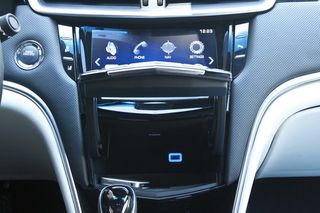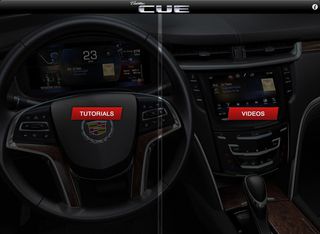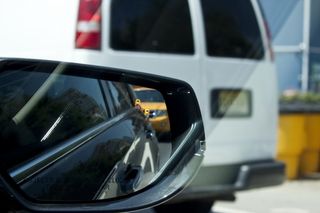2013 Cadillac XTS Review: A Geek's Dream Ride

When it comes to in-car technology, a simple iPod dock just doesn't cut it anymore. Drivers want systems that offer full blown smartphone information via Bluetooth, touchscreen interfaces and intelligent safety features that can warn them about impending collisions. To meet that demand, Cadillac has been working on its Cadillac User Experience, or CUE, telematics and infotainment system, a technology suite that Cadillac hopes will satisfy even the geekiest drivers on Earth.
Cadillac has made portions of the CUE system available in its 2013 SRX crossover and ATS small sedan. But it's in the all-new XTS, Cadillac's top dog luxury sedan, that users get access to the full CUE experience. So we jumped into a pre-production model of the XTS and took it for a spin through the gridlocked canyons of midtown Manhattan to see how well Cadillac has managed to meld technology and torque.
CUE
To be sure, Cadillac has never been a slouch when it comes to bringing tech into its vehicles. However, with the XTS, this auto maker is moving way beyond the Ensure set to target a more tech savvy audience, one that feels right at home using the latest and greatest smartphones and tablets.
[Read: Top 10 Teched-Out Cars 2012]
The XTS’s version of CUE is made up of two main displays, a customizable 12.3-inch digital instrument cluster and an 8-inch capacitive touchscreen located above the center console. It’s through the touchscreen that users can access CUE’s audio, Pandora, OnStar, weather, navigation, phone, climate and settings apps. You can also connect up to 10 devices via Bluetooth.

Tapping the touchscreen produces a satisfying “thunk” from its haptic feedback motor, letting you know that you’ve selected an on-screen item. Cadillac is the first to offer this feature in an infotainment system. The Detroit automaker has also included proximity sensors located just below the touchscreen that automatically displays a series of command buttons when a user brings his hand up to the display. After a short period of inactivity, the buttons slowly fade out, helping to ensure that users aren’t constantly bombarded with too much information.
Stay in the know with Laptop Mag
Get our in-depth reviews, helpful tips, great deals, and the biggest news stories delivered to your inbox.

Running along the bottom of the display are five customizable buttons that can be set up to give users quick access to things such as radio stations, individual songs from their smartphones or points-of-interest. Need some Starbucks? Save it to one of the favorites buttons as a POI. Each time you tap the button it will automatically open CUE’s navigation system and display every Starbucks in the area.
Opposite the favorites buttons, at the top of the screen, sits CUE’s apps shortcut bar. To add an app to the list, simply long press its corresponding icon on the CUE home screen and drag it up to the apps bar.

Our one complaint about the XTS’s touchscreen is that its 800 x 400-pixel resolution isn’t nearly as sharp as the Mercedes E350's HD display. While using the weather app, for instance, storm cells looked pixilated on the XTS’s display. We also noted a significant amount of lag while using the navigation system to locate points-of-interest in midtown Manhattan. That, however, can be attributed to the navigation’s 3D maps, as well as the sheer amount of data that CUE has to compile in such a crowded area.
[Read: 2012 Mercedes E350 Tech Drive: A Benz with Brains and Brawn]

In addition to the 8-inch touchscreen, the XTS features a customizable 12.3-inch digital instrument cluster. With the car turned off, the cluster looks as flat and black as a standard computer monitor. Turn the key, however, and the display comes to life with a beautiful animation. Cadillac allows its users to choose between four layouts for the instrument cluster: Balanced, Enhanced, Performance and Simple.

Each layout differs in the amount of screen space allocated to certain features. Performance, for example, features a large speedometer and tachometer, while Enhanced gives you a large digital speedometer, as well as navigation and audio information.
Cadillac outfitted the XTS with a HUD (heads-up display) that projects the driver's current speed, audio selection and techometer directly onto the windshield. When we first heard of the HUD, we assumed it would be distracting. Instead, we found our eyes to be more focused on the road, rather than roaming through our dash looking for directions, name of the song on the radio, current speed, etc. Once we got used to the HUD, which took all of 10 minutes, we were spoiled. Looking through a regular windshield now seems not only boring but unhelpful.

Below the XTS’s touchscreen you’ll find its HVAC controls. While CUE does provide access to some climate settings, Cadillac says its customer surveys indicated that most people preferred using physical knobs. Interestingly, the HVAC controls are touch sensitive, allowing Cadillac's engineers to hollow out the back of the HVAC cluster and give drivers access to a 1.8-liter storage compartment complete with two USB ports. Cadillac says that they are also working on implementing a wireless charger that will fit in this compartment, although the company hasn’t announced specifics.

Of course, no telematics system is complete without speech recognition, and Cadillac’s CUE has it in spades. Taking a page out of Apple's Siri book, the system uses what the automaker refers to as natural speech recognition. This all but eliminates the often agonizing task of remembering specific phrases to access CUE’s various menus and features. For example, you can say “Check weather" to open the weather app and get the forecast for your immediate area.

The sheer amount of settings and options CUE offers users will certainly be overwhelming to some. Tech savvy drivers will be able to pick up the majority of its functionality after a little more than an hour of use. Give it a week and you’ll be a pro. For those that have a more difficult time navigating CUE, Cadillac is offering educational sessions at dealerships. While taking a class to understand your car may seem like overkill to some, it does point to just how much the XTS improves and advances the current set of in-vehicle technologies.

If school is truly too much for you, there's also an iPad app called Cadillac CUE to help users get acclimated with the system. This free app includes video tutorials for beginner, advanced and expert users on all sorts of features, including how to make a call using the keypad or understanding Valet Mode. In a sense, you can "test-drive" the car yourself through this system to see how you like it.
MyCadillac App
Speaking of apps, Cadillac’s myCadillac app for iOS and Android devices provides XTS owners with easy access to a host of features such as Roadside Assistance, Parking Reminder and OnStar RemoteLink. With Roadside Assistance, users can quickly get in touch with a safety advisor who can pinpoint your vehicle’s location and provide help with vehicle towing services and lockouts. The aptly named Parking Reminder provides users with push notification alerts about how much time they have left on the parking meter and even locate it using GPS functionality.

With OnStar RemoteLink, myCadillac users can lock and unlock their XTS, start it remotely, check the fuel and oil levels and even make sure they have enough air in their tires. Other features included with myCadillac include a dealer locator, vehicle service scheduler, owner’s manual and offers page.
Safety
CUE isn’t the only new feature Cadillac is debuting with the XTS. The automaker is also using the vehicle to launch its new Safety Alert Seat. The technology, which Cadillac has patented, vibrates the driver’s seat when a potential hazard is detected. The Safety Alert Seat ties into the XTS’s other safety systems, including Forward Collision Alert, Lane Departure Warning, Side Blind Zone Alert and Cross Traffic Alert. Each of the safety systems utilizes a combination of Doppler radar, ultrasonic motion detectors and high-definition cameras to detect nearby vehicles or other objects.

The XTS’s Forward Collision Alert alerts drivers when they are getting too close to another vehicle or object, and vibrates the Safety Alert Seat if you get within a set range. Users can customize the distance between their vehicle and the oncoming object, as well. So if you’re a particularly aggressive driver, you can set the system to activate when you are very close to another vehicle. However, if you’re a more passive driver, you can set the system to activate at a further distance.
Cadillac’s Lane Departure Warning system, does just what its name suggests: it warns you when you are swerving from your lane. The system uses a camera in the XTS’s rear-view mirror to track lane markers. When you cross over a marker without using a turn signal, the Lane Departure Warning will send a signal to the Safety Alert Seat, which will vibrate based on which lane you are moving into. Cross the left lane marker, and the left side of the seat will vibrate. Cross the right marker, and the right side of the seat will vibrate.
Unfortunately, unlike systems available through Ford and Mercedes, Cadillac’s does not steer or pull you back into the appropriate lane when it senses you drifting. Plus, we found this feature particularly distracting, and often times distressing.

Side Traffic Alert works by detecting when other vehicles are in your blind spot. When the system detects a vehicle it will automatically display a bright amber indicator in the appropriate side view mirror, as well as send pulses to either side of the Safety Alert Seat.
Two of our favorite safety features included with the XTS are its Rear Cross Traffic Alert and Park Assist. Rear Cross Traffic Assist uses sensors in the rear of the vehicle to alert drivers backing out of a parking space when a car is coming from the left or right based on pulses sent to the Safety Alert Seat. Meanwhile, Park Assist uses the XTS’s rear-facing camera to stream images to the XTS’s 8-inch display and flashes an alert on the screen where the object is located. The system also vibrates the Safety Alert Seat based on the position of the object.
The Ride

Like the CTS, XRS and ATS, Cadillac’s XTS follows the company’s “Arts and Science” design language. Its chrome trapezoidal grill has an almost brooding appearance that is only accentuated by its gorgeous high-intensity discharge headlights, along the edges of which you’ll notice vertical LED running lights. The XTS’s skin has sharp angular creases throughout, giving it a muscular feel.
We were especially fond of the car’s center-mounted rear light that doubles as a spoiler. We were not, however, too fond of the XTS’s stubby snout. When looking at the XTS’s profile, it looks as if its grill and front tires are separated by mere inches.
Slide into the XTS’s leather driver’s seat and you’ll immediately feel as though you’re seated at the helm of a luxury cruise ship. That’s because at 202 inches long, the XTS is the largest sedan in Cadillac’s admittedly small stable. There’s more than enough room in this car for a family of four. The XTS’s interior is definitely befitting that of a Cadillac. The wood inlays and leather covers lining the dash fit perfectly, leaving no unsightly seams.

The once conventional wisdom of every large sedan needing an equally large V-8 engine went out the window with $0.89 per gallon gas. Instead, Cadillac has dropped one of its 3.6 liter direct-injection V-6 engines into the XTS. And with 304 horsepower and 264 lb.-ft. of torque being sent to all four wheels, the XTS hustled across town. At no time did we feel bogged down by this car's size.
Finish Line

The 2013 Cadillac XTS is an incredibly important vehicle launch for Cadillac. Not only is it the debut of a new auto, but several new technologies as well. Overall, we enjoyed our experience with this sedan. The CUE system is powerful and versatile, and the heads-up display is very well executed. Once you spend a bit of time learning the settings, navigating the XTS' various menus and apps will become second nature. The vehicle’s safety features are top-notch, and its elegantly appointed interior, slick exterior and brawny V-6 engine combine to make a luxury car that should satisfy many drivers.

